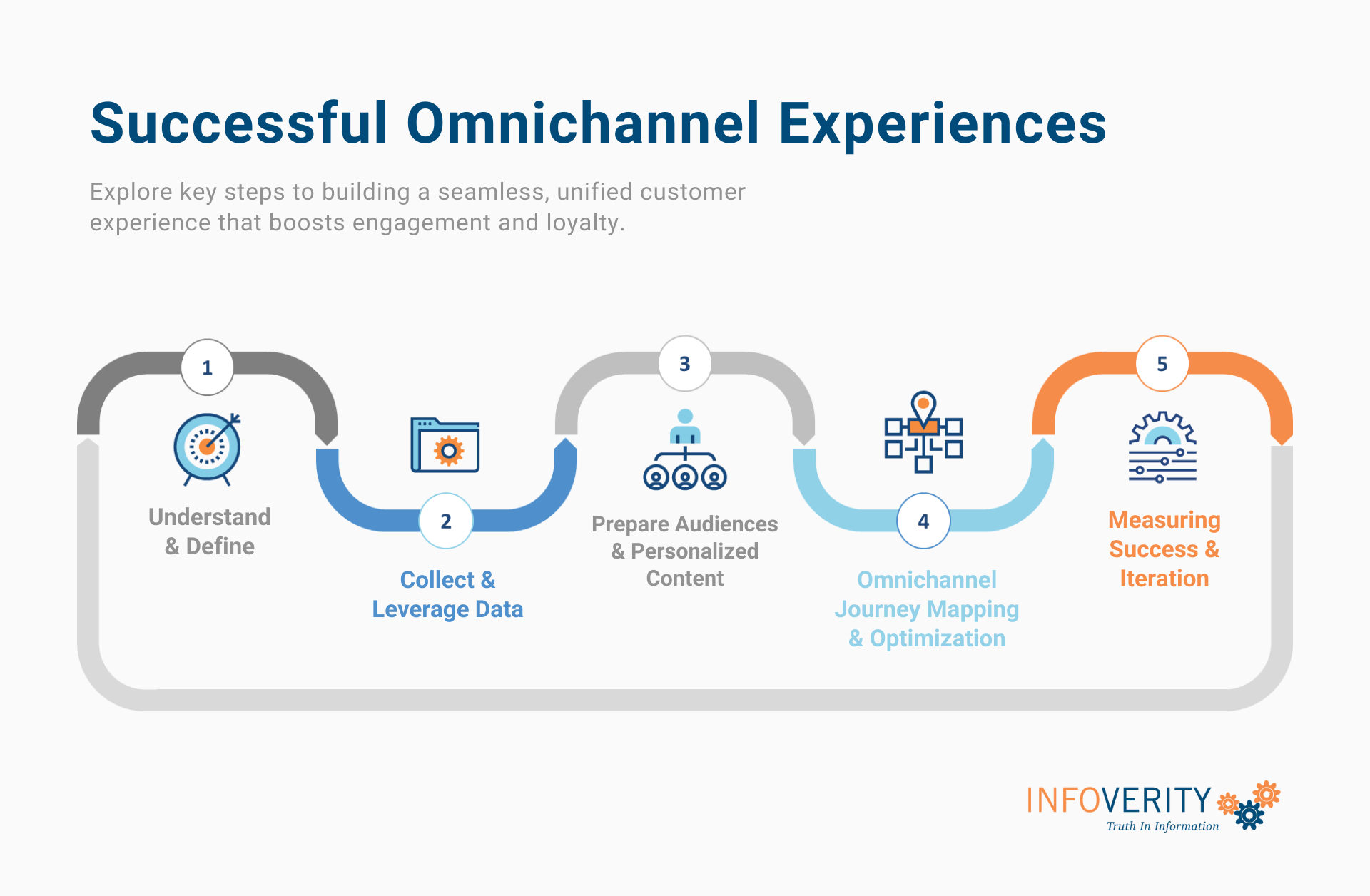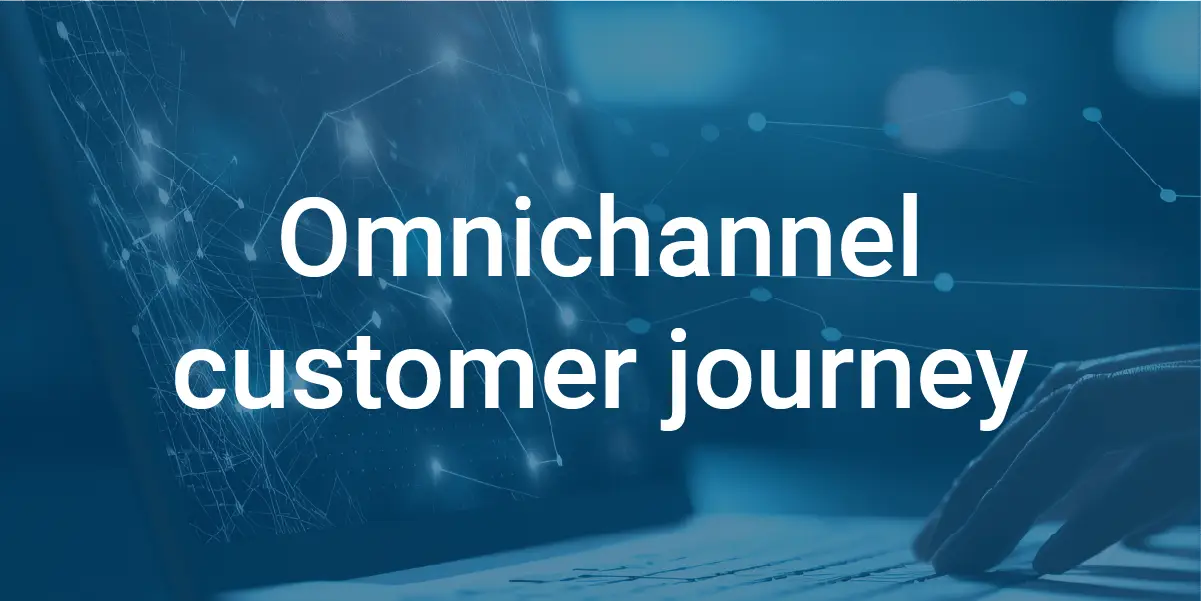According to a recent Salesforce report, 90% of consumers believe that a company’s customer experience (CX) is just as crucial as the quality of its products or services. Furthermore, businesses focusing on omnichannel customer journey mapping can better understand consumer behavior and make data-driven decisions to improve customer experience.
This article will discuss the importance of optimizing omnichannel customer journeys by tracking and integrating customer interactions across multiple channels. Moreover, it will provide strategies for capturing data from various touchpoints and leveraging customer insights.


Omnichannel Customer Journey: Table of Contents
Omnichannel Journey and Customer Experience: An Overview
Today, consumers interact with a brand through various channels, such as:
- Websites
- Brick-and-mortar stores
- Mobile applications
- Text messages
- Customer support
Thus, customer expectations, and thus customer experiences, have changed in the digital world, regardless of the touchpoint (i.e., product information, checkout process) or channel used. In order to meet customer expectations, brands should be using the data collected about their customers to better serve them.
From the brands they interact with, they also expect:
- Personalized experiences,
- Relevant offers,
- Proactive outreach,
- Quick responsiveness, and
- Streamlined customer support.
Statistics
Emplifi research shows that 86% of consumers would leave a brand after only two poor experiences. Mapping omnichannel customer journeys can systematically drive positive customer experiences at scale.
Omnichannel experiences enable organizations to leverage customer data collected across multiple channels and touchpoints. By understanding and optimizing the customer journey, businesses can improve customer interactions to boost customer experience and satisfaction and increase revenue through product recommendations.
Furthermore, organizations can enhance business performance and save costs by automating the customer journey execution at scale.
Journeys also facilitate the ability to suppress advertising to recently converted or low value customers and amplify targeting for identified high-value customers.
In layman’s terms, omni-channel journey strategies enable organizations to understand and optimize the end-to-end customer experience across devices and channels.
What is the Omnichannel Customer Journey?
An omnichannel customer journey is an integrated string of events during which customers interact with a brand across multiple channels such as:
- Websites,
- Mobile applications,
- Marketing campaigns,
- Social media, and
- In-store.
Customer journeys define events and movement throughout the marketing/sales funnels with a general goal to increase engagement, conversion, and loyalty.
Let’s take a business who has online and offline stores as an example. The omnichannel customer journey starts when the potential customer clicks an ad and creates an account, ends when the customer makes a purchase and receives loyalty points, and includes all the touchpoints in between that drove the customer towards the purchase.
The touchpoints include all the interactions with the brand through various channels including email, social media, and in-store, as well as other synergies with the brand’s mobile application and store experience.
An effective omnichannel customer experience occurs when the customer receives the right message or offer, at the right time, on the right channel. Businesses must use data to decide what is “right” for each customer.
An Omnichannel Customer Journey Example
Imagine a potential customer browsing Facebook during their lunch break. They come across an ad for a popular fashion brand. Moreover, they click on the ad and explore the brand’s website – ultimately creating an account and downloading the brand’s app. The potential customer adds a few items to their online cart, but then returns to work.
Later that evening, they receive a personalized email with a discount code for the items in their cart. The next day, while commuting, they receive an email from a brand ambassador asking if they have any questions about the products in their cart and confirming inventory availability.
Finally, during the customer’s lunch break, they visit the store, try on the clothes, and make a purchase using the discount code provided. Upon purchase, they receive loyalty points & other recommended clothes that similar customers have purchased.
In this example, the customer received timely offers, personalized customer support, and relevant recommendations that ultimately led them to making a purchase.
Looking for optimizing omnichannel customer journeys?
Infoverity can assist you in gathering a holistic view of your customer data and empower you to create truly personalized, seamless omnichannel customer experiences. 
Creating Successful Omnichannel Experiences – From Start to Finish
The previous example seems so simple in practice, but requires significant analysis, planning, and data to drive the personalized customer journey.
According to a 2024 report, 46% of customers polled by Forbes are more likely to purchase more when they have a personalized experience. Here, we have listed the steps to create a superior unified customer experience.

1. Understand & Define
To create targeted and seamless experiences, organizations must first:
- Understand existing customer journeys and journey performance to learn existing customer behavior. Analyzing each stage of an existent buyer’s journey enables organizations to identify and address potential barriers throughout the whole buying process preventing customers from completing the purchase.
- Define the omnichannel customer journey and its stages. It starts with understanding how the customer becomes aware of the problem they are facing (awareness). Thus, it continues with the consideration of potential solutions, the decision to purchase, retention, and advocacy.
- Identify relevant touchpoints and channels and ensure that they are cohesively incorporated in the journey. These may be physical stores, social media, online stores, self-service portals, and mobile apps.
- Detail the goal of each journey. Goals may include increasing product/service purchases, enhancing customer loyalty, expanding into new markets, or even suppress advertising to recently converted or low value customers.
- Define the data required to complete the journey. Often, brands can define a compelling customer journey, however they lack the data required to execute it. Use this as an opportunity to define first- and zero-party data capture strategies to collect context relevant information directly from customers.
2. Collect & Leverage Data
To gain valuable insights into customer behaviors and preferences:
- Collect customer data. Depending on the channel, information should include name, contact details, behaviors, preferences, and demographics. Data collection should be thoughtful in terms of the types of data collected per channel, and the timing of data collection in the wider journey.
- Consolidate all data into a single location. Data integration tools enable organizations to consolidate all information by seamlessly bridging online and offline data into a single location.
- Use Customer Data Platforms (CDPs). Businesses often employ these platforms to manage customer data collected throughout the entire customer lifecycle. For instance, an organization could use a CDP to collect data from touch points like campaign engagement, mobile apps, and its online shop. Then the CDP consolidates those datapoints into a unified customer profile that can be utilized to send targeted activations or used by other systems.
- CDPs are one of many different technology solutions that can enable omnichannel customer journey automation. There are other systems that do similar things such as marketing automation platforms (MAPs) and other dedicated journey tools.
3. Prepare Audiences & Personalized Content
Research shows that 65% of customers expect companies to adapt to their changing needs and preferences. Businesses can enhance personalization through several initiatives.
- Using unified customer profiles. Unified profiles enable marketers to understand each customer’s entire set of interactions with their brand, along with all their information. This increases the speed at which marketers can execute a campaign.
- Creating personalized content tailored to customer segments. Such content can be based on purchases, engagement history, web browsing activity, and demographic data. For example, resellers can create an ad-hoc advertising campaign specifically addressing those customers who visited a specific page on their website.
- Use personalization and segmentation. It will ensure each customer touchpoint is valuable and relevant. Not all consumers are made equal. Some might be heavy social media platform users. Others prefer the more traditional newsletters. Customer segmentation empowers enterprises to target the most impactful channel for each customer.
4. Omnichannel Journey Mapping & Optimization
Mapping the omnichannel customer journey helps organizations gain a holistic view of the customer experience. Also, it facilitates the identification of potential gaps and improvement areas through various techniques.
- Launch the journey and gather data. How is the journey performing? What can we take away from customer behavior? Are there specific journey stages where customers are getting stuck for a long period of time, and what does that tell us about our marketing strategy, etc.?
- Utilize a marketing technology solution. Configure the omnichannel customer journey based on the data gathered. Furthermore, several CDPs and marketing cloud platforms have technologies to enable these.
- Identify gaps in the existing customer journey. For example, clients might get frustrated when they have to wait a long time for a reply from customer service. Or, they might abandon their cart because they cannot use their preferred payment method.
- Experiment. Test different communication channels and identify the messages and offers that contribute to the desired customer journey goals, and push customers through each funnel.
5. Measuring Success & Iteration
Businesses should constantly track the performance of omnichannel customer journey optimization efforts.
- Define key performance indicators (KPIs) according to the specific journey. Each omnichannel customer journey should have a desired outcome/behavior to drive towards. In turn, each marketing strategy goal must be defined and measured by KPIs. For instance, conversion rates are great for assessing sales. Customer satisfaction is a typical KPI that is directly linked to customer loyalty. Other KPIs include Customer Acquisition Cost (CAC), Average Order Value (AOV), and Churn Rate, among many others.
- Iterate and optimize each journey over time. Customer journeys are dynamic and continue to change with culture, customer preferences, seasonality, etc. In order to maximize the value of omnichannel customer journeys, it is important to continually evaluate journey performance and gather customer feedback.
Building Personalized and Seamless Omnichannel Experiences
A successful omnichannel customer journey should provide timely and relevant value to each customer as they interact with a brand. To attain it, data-driven companies must invest in:
- Meticulous journey design, including understanding what outcomes you’re looking to achieve
- Data collection, categorization, and analysis
- Data activation
Infoverity‘s data solutions and services can help you do exactly that. Get in touch. We will assist you in gathering a holistic view of your customer data and empower you to create truly personalized, seamless omnichannel customer experiences.
FAQ – Omnichannel Customer Journey
What is an omnichannel customer journey?
An omnichannel customer journey is an integrated string of events during which customers interact with a brand across multiple channels such as: websites, mobile applications, marketing campaigns, social media and in-store. Customer journeys define events and movement throughout the marketing/sales funnels with a general goal to increase engagement, conversion, and loyalty.
How does catalog management support growth and efficiency in business?
Catalog management isn't just about organizing product data—it's a key driver of operational efficiency, scalability, and growth. From e-commerce to global retail operations, practical use cases show how businesses are applying catalog management to stay competitive and customer-focused.
How to create successful omnichannel experiences?
Building a seamless omnichannel experience requires more than just being present on multiple platforms—it’s about creating a unified, personalized journey for your customers. 46% of customers are more likely to increase their purchases when they receive a tailored experience. When done right, omnichannel strategies strengthen customer relationships, improve engagement, and drive growth.
How does a successful omnichannel customer journey work?
A real-life example shows how strategic, personalized engagement across touchpoints can turn curiosity into conversion. That seamless experience? It’s omnichannel done right—integrating social media, email, mobile, and in-store touchpoints to drive engagement and loyalty. Personalization, timing, and relevance make the difference.

